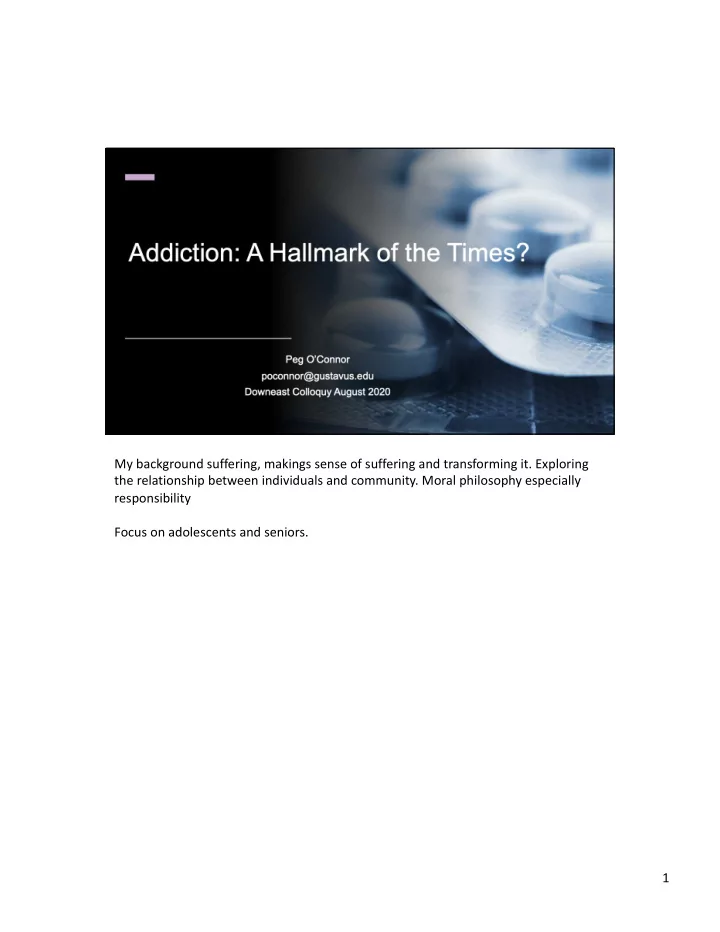

My background suffering, makings sense of suffering and transforming it. Exploring the relationship between individuals and community. Moral philosophy especially responsibility Focus on adolescents and seniors. 1
Illness or disease illness language enters the scene in the 1850s and has evolved over time to allergy (early AA) or a disease. But disease of what sort? COPD, Type II diabetes are diseases very different from cystic fibrosis, for example. The focus is entirely on individuals. We’ll start here but quickly move to broader social/political/economic considerations 2
Neuroscience and medicine are winning the battle to define addiction. Analogy of hijacking the brain. Parkinson drugs Requip and Mirapex imitate function of dopamine. Gambling, shopping, sex/internet addiction 3
4
5
6
7
8
Here the emphasis is still on individuals but let’s pull the lens back one layer. There are strong causal links between childhood trauma, SUDs, and PTSD. 9
Gun violence in schools with active shooter drills. Detention centers and effects of the pandemic. The more adverse experiences a person experiences, the greater the risk of addiction. ACE score of 5+ are up to 10x more likely to experience addiction that people without ACE. 10
A child will receive a diagnosis of PTSD plus often one of these. But PTSD was a diagnosis developed for returning vets. Developmental trauma disorder instead but rejected for inclusion in the DSM-5 11
Availability of resources to meet daily needs (e.g., safe housing and local food markets) Access to educational, economic, and job opportunities Access to health care services Quality of education and job training Availability of community-based resources in support of community living and opportunities for recreational and leisure-time activities Transportation options Public safety Social support Social norms and attitudes (e.g., discrimination, racism, and distrust of government) Exposure to crime, violence, and social disorder (e.g., presence of trash and lack of cooperation in a community) Socioeconomic conditions (e.g., concentrated poverty and the stressful conditions that accompany it) Residential segregation Language/Literacy Access to mass media and emerging technologies (e.g., cell phones, the Internet, and social media) Culture 12
Both Alexander and Hari claim that the drugs don’t really have so much to do with it as we think. It is more a matter of dislocation and fragmentation such that people lack fundamental life affirming connections. Too much of a one-sided diet? Failure of the War on Drugs. 13
Yes, there are now many more seniors than there were in 2006 because of the size of the Baby Boom generation so the raw numbers will be higher. It is also true that longevity has been increasing. Number of older Baby Boomers 70+ is projected to climb to 32.8 million this year (up from 21.7 million in 2010). In 2040, the number climbs to 38.6 million. Source: https://www.jchs.harvard.edu/sites/default/files/jchs- housing_americas_older_adults_2014-ch2_0.pdf 14
Use the same language for seniors drinking as we do for college drinking 15
16
10-15% of people do not start to drink until they are older/seniors. Why? Aging bodies are more sensitive to alcohol and respond differently from younger bodies: Slower rate of metabolism of alcohol so it sits in organs longer; Less muscle to absorb alcohol (lose 1% muscle each year); Less water in body (between ages of 20 and 80, there’s a 15% decrease in water) so there is a higher percentage of alcohol in blood than a young person consuming same amount; Dehydration slows metabolism and alcohol contributes to dehydration and affects kidneys creating a vicious cycle. ck to social determinants of health 17
Office of National Drug Control Policy Interdiction means interrupting the illegal flow of drugs, figuring out the routes, shutting them down etc. 18
Safe injection sites? Wet houses in Minneapolis Anishinabe Wakiagun is a culturally specific permanent supportive housing program for chronic inebriates. Residents must have 20 or more admissions to detox centers in the last three years, two or more attempts at chemical dependency treatment, and have been homeless the majority of the last two years. Other indicators of eligibility include physical deterioration and evidence that the individual is incapable of self-management due to alcohol use. Iceland high rate of dangerous binge drinking with adolescents 19
20
21
Barbiturates are far less common now than in 1960s and 70s, which shows how a drug’s addictiveness or danger is in large part a matter of context and environment. Used to be prescribed for extreme anxiety, epilepsy, insomnia, seizures. 22
Recommend
More recommend